
If you saw the above work and thought “Bougeureau,” you could be forgiven. Hugues Merle (French, 1823-1881) is in many ways a forgotten proto-Bougeureau. Merle and William-Adolphe Bougeureau (1825-1905) knew one another well and, for a time, were represented by the same gallery. Born two years apart, both graduated from the École de Beaux-Arts, were members of the French Academy and regulary exhibited at the annual Paris Salon. Their penchant for mythical, allegorical and literary scenes combined with mastery of the monumental human figure, made them competitors for the same pupils, positions, prizes and patrons. While Merle was only two years Bouguereau’s senior, he died nearly a quarter century earlier. A strong argument could be made–and I may tackle it some day–that had Merle lived to Bouguereau’s age, memory of his work would have not suffered such anonymity.
Two years ago, someone I know bought major work by Hugues Merle–Romeo & Juliette (1879). Since then, Merle has become a pet project that has taken me to France, England, Belgium and the United States in search of primary documents and published materials. There is disappointingly little available on public record. By increasing awareness of his work, its my goal to encourage those who have information relating to Merle to raise their hands and help us all piece together the life and work of an artist to has a lot to offer.
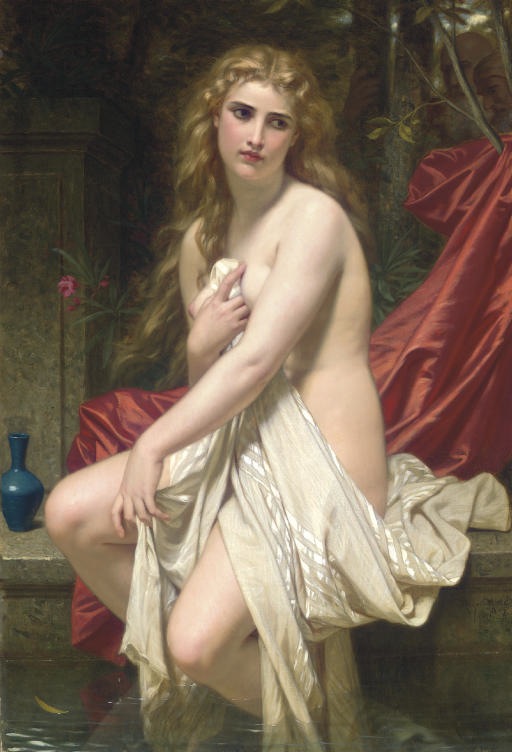
There is a precedent for this. Thirty years ago, Damien Bartoli (1947-2009) took up the cause of Bouguereau and worked to produce a catalogue raisonné for the artist. Sadly, Bartoli died last month; but, not before publishing dozens of articles and submitting his final manuscript of Bouguereau’s complete works. (It will be this by the Antique Collectors’ Club in London.) Over the same 30 years, Bougueraeu has experienced a revival. Although it would be hard to establish a causal relationship, since Bartoli picked up his pen Bouguereau has seen a dramatic increase in awareness, appreciation and prices for his work. I’m no Bartoli and Merle is not Bouguereau. But, as Bougeureau’s star continues to rise, I believe it is only a matter of time until Merle’s follows. The two were closely associated in life and deserve to be in death.
Hugues Merle was born in Saint–Marcellin in the region of Isère (i.e. Southeast France). Little is know about his family or upbringing. As a community, Isère was politlcally charge, known for strong Protestant roots and nearly uniform support for the Empire. Early in his career, Merle painting a number of pro-Empire works that may be a reflection of his origins.
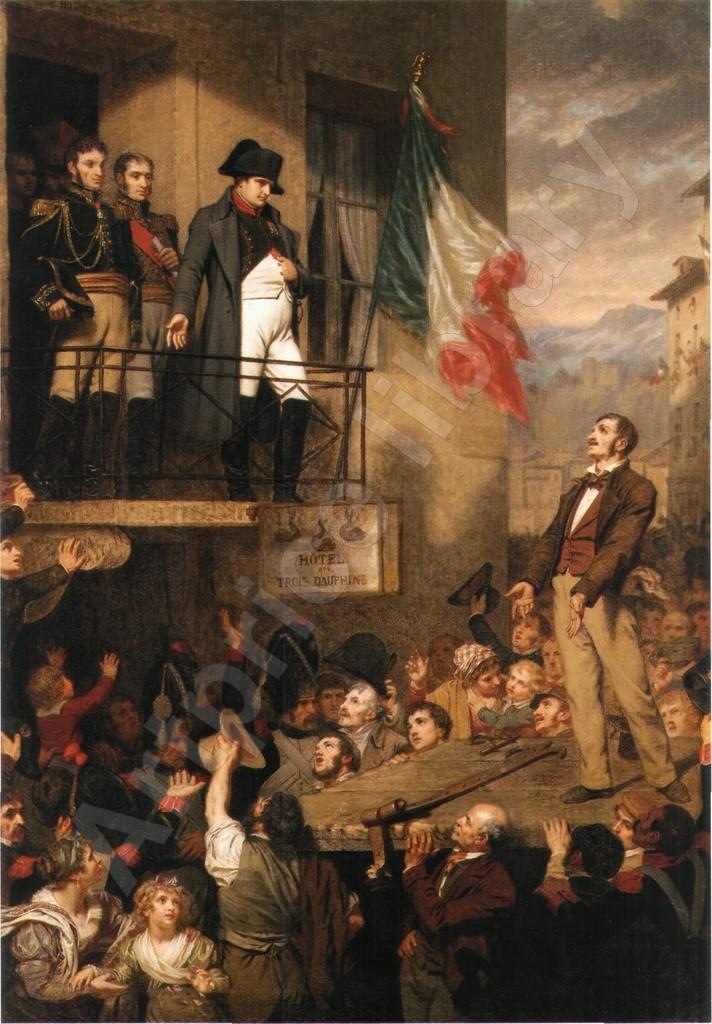
Merle was accepted as a student at the École des Beaux-Arts in Paris, the nation’s most prestigious school for aspiring artists. There he enrolled in the studio of Léon Cogniet (1784-1880). Cogniet had studied at the École under Pierre -Narcisse Guérin, at same time as Eugene Delacroix, Ary Scheffer and Theodore Géricault, with whom he maintained life-long friendships. While he distinguished himself by winning the Prix de Rome in 1817, Cogniet is largely remembered as a teacher. Of him, Baudelaire wrote:
If he does not aspire to the level of genius, his is one of those talents which defy criticism by their very completeness within their own moderation. M. Cogniet is as unacquainted with the reckless flights of fantasty as with the rigid systems of the absolutists. To fuse, to mix and combine, while exercising choice, have always been his role and aim; and he has perfectly fulfilled them.
(Charles Baudelarie. The Mirror of Art, rans. and ed. by Jonathan Mayne. New York: 1956, p. 21)
Cogniet students include some of the century’s most respected painters, including Alfred Dehodencq, Jean-Louis Ernest Messonier, Jules Joseph Lefebvre, Léon Bonnat, Raimundo de Madrazo, and Jean Paul Laurens. As a teacher, Cogniet advocated vigorous and rough sketching above meticulous, time-consuming preparation. This became what Albert Boime described as “the sauce Cogniet [that] became a popular epithet to describe the technique of his disciples.” (Art and the Academy, p. 104). This resulted in a fluid naturalism in Cogniet’s own work, which influenced Merle’s approach during the the 1840s and 1850s.
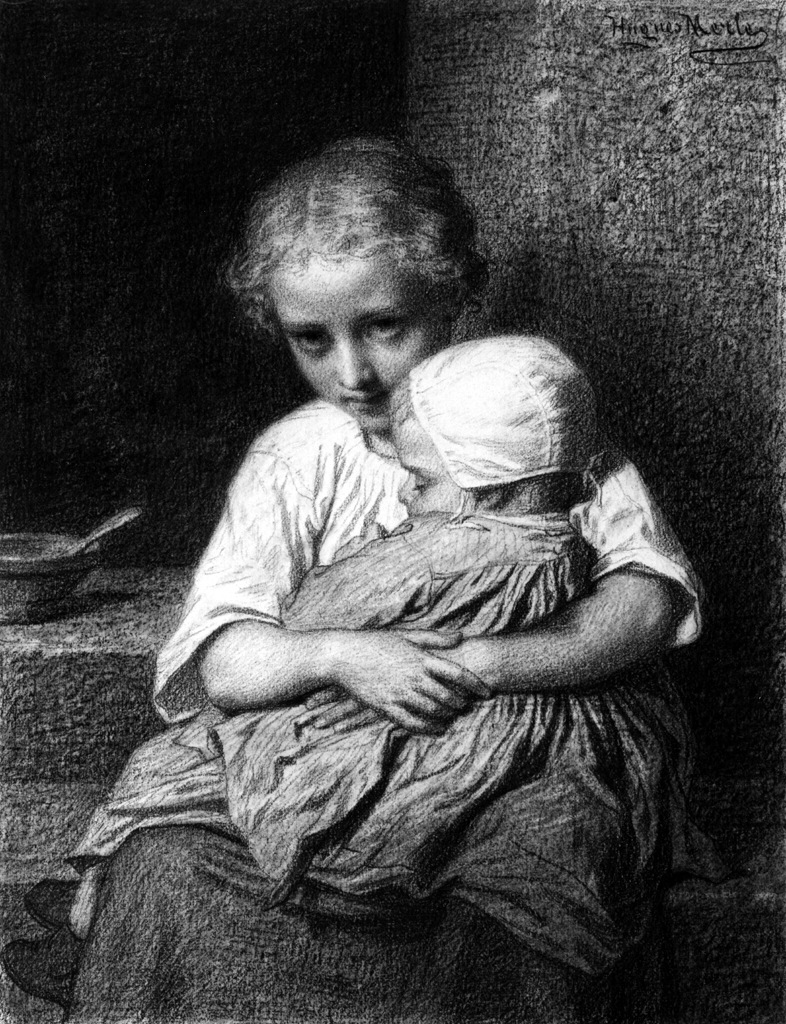
Having seen nearly 200 of Merle’s works (I have no idea how many he painted yet), ranging from the early 1840s to his death in 1881, I would divide his ouvre into roughly three periods:
- Multifigural History Painting (1840s and 1850s)
- Genre Scenes (1850s and 1860s)
- Monumental Romantic Figures (1860s t0 1881)
1. MULTI-FIGURAL HISTORY PAINTING (1840s and 1850s)

It is no surprise that works from early in Merle’s career have more in common with Cogniet’s work than his latter works. They are politically-charged or mythological history paintings–the kind that students at the École were trained to produce. Like Cogniet, many of these works are romantic in coloring and stroke. The brushwork is loose and the palette is warm.
2. GENRE SCENES (1850s and 1860s)
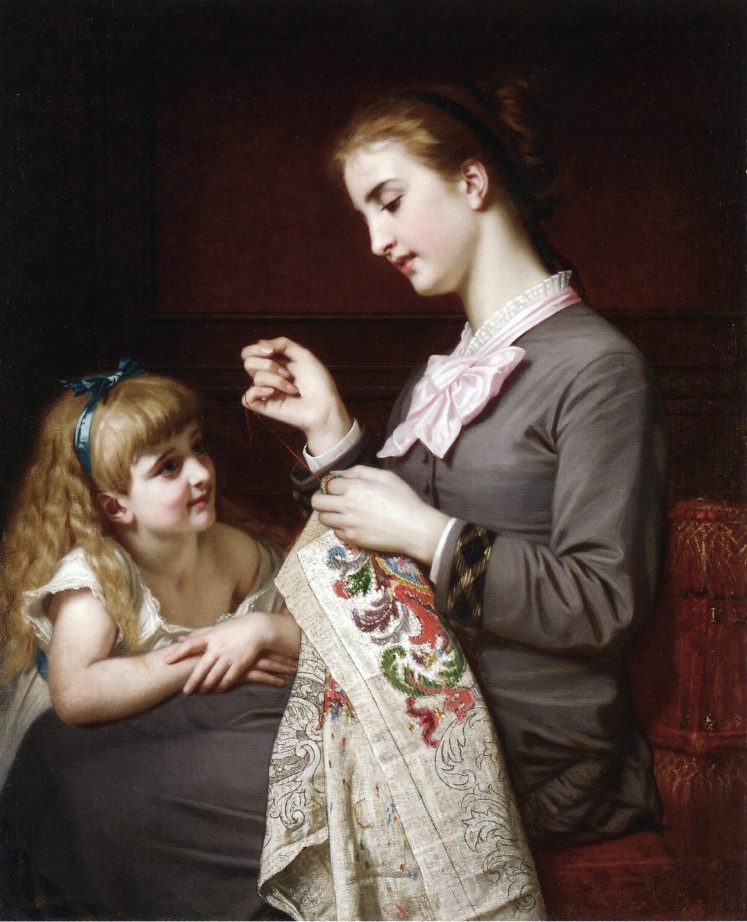
It is my guess that once he had established his academic credibility, Merle had to make a transition into becoming a commercial success. In mid-nineteenth Paris, this meant appealing to the bourgeoisie. Rather than mythological or heroic scenes that appealed to aristocratic tastes or political agendas, the easy sell to the upwardly mobile French middle classes was domestic family life and narratives lionizing traditional French values. Merle painted pictures of mothers and daughters, family gatherings, country scenes and home interiors. According to one source, it during this period Bougeureau and Merle had the same picture dealer, and that dealer encouraged Bougeureau to take up Merle’s successful theme of familial grieving.
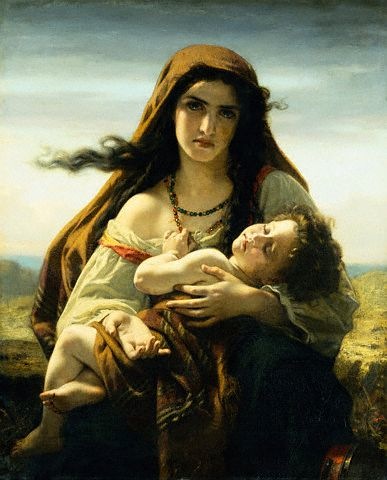
In this era, Merle developed his own technical approach that distanced him from Cogniet. He replaced warm colors with a high-contrast, jewel-like palette. His paintings became sparsely populated and the remaining figures grew in proportion to fill the canvas. As the figures grew, they became more idealized with an emphasis on line over color.
3. MONUMENTAL ROMANTIC FIGURES (1860s t0 1881)
Merle’s critical successes in the Salons of the 1860s led gave him international recognition. Like many others, Salon prizes resulted in a lucrative business of painting portraits Brits and Americans. But, it was Merle’s work as an interpreter of major literary romantic figures that set him apart.
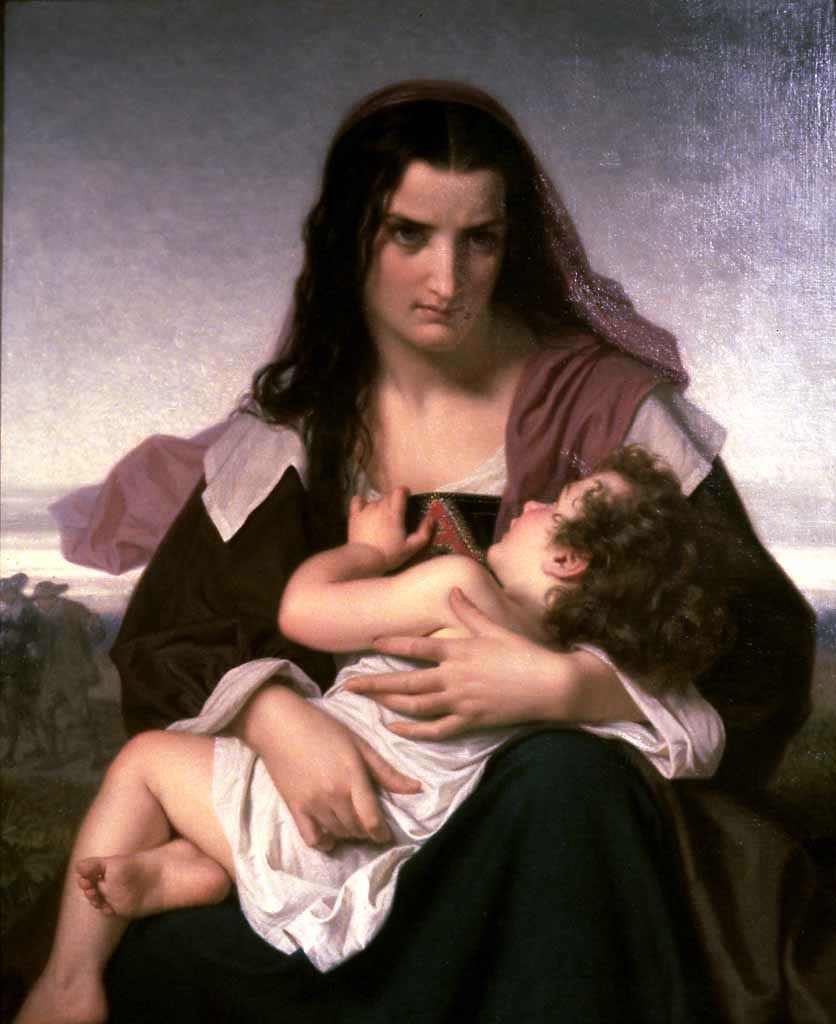
Upon seeing a photo of Merle’s interpretation of the Scarlett Letter, Nathaniel Hawthorne is purported to have said: “It is the most true representation of my work I have ever seen.” Merle painted a number of biblical and literary figures, especially romantic couples, including Tristan & Isolde, Benedick & Beatrice, and Romeo & Juliet. These figures were painted as large as life. They dominated the canvas. Merle removed all unnecessary narrative devices, relying on his audience’s familiarity with the subjects.
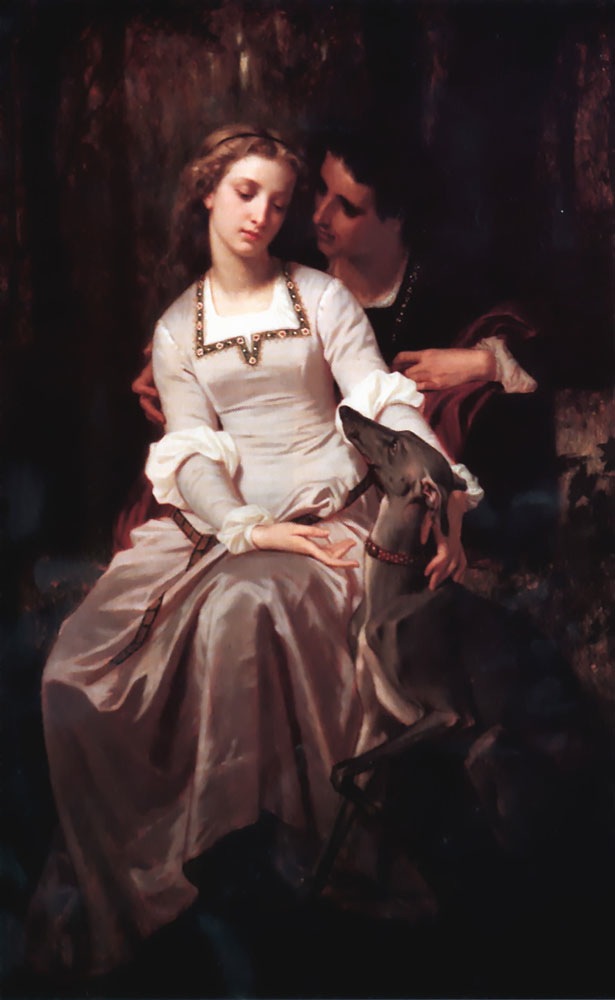
In 1865, François-Victor Hugo (Victor Hugo’s son) had translated the complete works of Shakespeare into French. For the next fifteen years, the French poured over and re-interpreted the Bard’s narratives in ballets, operas, sculptures, and paintings. Merle’s Romeo & Juliette depicts the couple’s first meeting in Act I, Scene V. Here Romeo steals a “pilgrim’s kiss” from Juliet who coyly responds “You kiss by the book.”
The increased sophistication of Merle’s subjects was rising mastery of the human form. While his treatment of the clothed figure indicate his skill level, it is in nude that we are able to see an artist’s true mastery of the figure. Bougeureau’s female nudes leave us in awe of his skill and ensure his immortality. There are accounts of several painting of nude figures by Hugues Merle that have not surfaced in the art market. For me, this is a major omission in his ouvre and one that will continue to dog him if he is to regain stature.
[…] Merle’s later works centered familial love. Merle and his friend and fellow painter Bouguereau found lucrative employment with Goupil, and Merle became the teacher of Bouguereau’s wife, Elizabeth Gardner. If you like Merle’s work I recommend this site: http://beardedroman.com/?p=562 […]
SIMPLY SUPERB
Sisters by Hugues Merle. I own it.
I’d love to see a picture of it. (I won’t share the picture on the site, unless you want me to.)
You can email me, glynr@mac.com and I will send you a picture.
I am interested in your study of Hugues Merle.
I have a work entitled ‘Home Treasures’. It is unsigned but the composition is identical to an illustration from the Illustrated London News of 1870. I am unsure if this is a genuine H. Merle. It has been in my family for as long as anyone can remember and may have been given to, or purchased by, my great grandfather, the artist, Sir John E Millais.
I would be so pleased if you could shed more light on this work or if you know of it’s existence anywhere else. I have a feeling that my painting may be a copy as the brushwork is less detailed than the illustration.
I am researching the painting “Home Treasures” and would love any information you have about your Merle (or copy). I can be reached at merle.research@gmail.com
Thank you!
Hello,
I am wondering if you have information on the location of the original painting by Hugues Merle of Mary Magdalene in the Cave (1868).
I am gathering paintings of Mary Magdalene and trying to identify the artist, the date of completion and the location of the original. This information and a photo of each painting will come out in my blog entitled: “Images of Mary Magdalene through the centuries….”
If you are interested you can view on my website:
http://www.magdalenepublishing.org/
Any help in answering my question is greatly appreciated.
Sincerely,
Paula Lawlor
I’m sorry it has taken me so long to respond to your comment. I’ve been on extended sabbatical and not looked after this blog as I should. I know that the Magdalene in the Cave was recently sold at auction through Sotheby’s in New York. I don’t know to whom it was sold. (That is usually not public information.) But, if you are looking for an image and can’t find an adequate one online, I would contact Poly Sartori, Head of 19th Century European Paintings at Sotheby’s in New York — her contact information is at the bottom of this page: http://www.sothebys.com/en/departments/19th-century-european-paintings.html. She can usually get you the image that Sotheby’s used.
I have a framed print I found 30 years ago in a junk shop near Boston. “Marguerite” from Faust, holding a mirror, the daft nanny, holding the jewel box, beside her, Mephistopheles leering down at them from behind a high backed chair. A.A. Childs & Co. Printed on heavy cardboard.
I would love to see a photo of your print. Feel free to pass it on, and I may at it to the post. My email is: mjc “at” beardedroman.com.
Can you please give me your opinion about a painting I have? How can I send a pictures of it? Thank you
Yes, I would be happy to help. Please send what you have to my email address: mjc “at” beardedroman.com.
Sir, I don.t know I couldn.t use the email adress, but I send photoes of the painting on Facebook message. Thank you so much for beeing so king.
Feel free to send them to my other email address: micah.christensen “at” gmail.com
Great post.